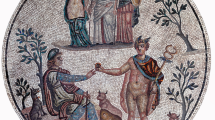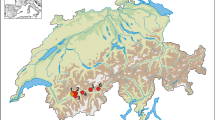Abstract
Fictile tubes (or vaulting tubes) are architectural elements that sustain and underline the shapes of cupolas and vaults. Several of these, sampled in three churches of Milan (S. Ambrogio, S. Lorenzo and Duomo) have been recently dated at the Archaeometry Laboratory of Milano Bicocca University.
These architectural elements, differently shaped, styled and sampled from different structures, were all produced, according to thermoluminescence (TL), in the period 970–1080 AD.
Energy dispersive X-rays fluorescence (EDXRF) measurements were performed to obtain the elemental composition of the clays and to attempt a classification of the samples. Multivariate PCA (principal components analysis) analyses and HCA (hierarchical clusters analysis) did not show any grouping of similarity. On the basis of the results, a tentative historical interpretation could be proposed.
Similar content being viewed by others
References
L. Fieni, L’architettura medievale, in: La costruzione della basilica di San Lorenzo a Milano (Silvana Editore, Cinisello, Balsamo, Milano, 2004)
N. Gallo, M. Martini, E. Sibilia, Building archaeology, 14C and thermoluminescence: two examples in comparison, in: 3th Symp. 14C and archeology, 6–10 April 1998, Lyon France
M.J. Aitken, Thermoluminescence Dating (Academic Press, London, 1985)
D.W. Zimmermann, Archaeometry 13, 29 (1971)
L. Bonizzoni, L’analisi chimica nello studio delle ceramiche archeologiche, PhD Thesis, Università degli Studi di Milano (2006)
R.A. Jones, Greek and Cypriot Pottery (The British School Eds., Athens, 1986)
M.J. Baxter, C.E. Bluck, Data Handling and Statistical Analysis, in: Modern Analytical Methods in Art and Archaeology, ed. by E. Ciliberto, G. Spoto (Wiley Interscience, New York, 2000), p. 681
H. Neff, Neutron Activation Analysis for Provenance Determination in Archaeology, Modern Analytical Methods in Art and Archaeology, ed. by E. Ciliberto, G. Spoto (Wiley & Sons, New York, 2000)
R. Aruga, Talanta 47, 1053 (1998)
S.S. Shapiro, M.B. Wilk, Biometrika 52, 591 (1965)
C. Capelli, La caratterizzazione minero-petrografica dei laterizi di San Lorenzo. Dati preliminar, in: L’eredità di Monneret de Villard a Milano (Ed. Insegna del Giglio, Firenze, 2004)
B. Oltrocchi, Ecclesiae Mediolanensis historia ligustica, in: Romanam Gothicam Langobardicam (Galeati, Milano, 1795)
E.A. Arslan, Bollettino d’Arte I-II gennaio-giugno 45 (1965)
Author information
Authors and Affiliations
Corresponding author
Additional information
PACS
78.66.Jg; 87.60.Kn; 78.70.En
Rights and permissions
About this article
Cite this article
Galli, A., Bonizzoni, L., Martini, M. et al. Archaeometric study of fictile tubes from three churches in Milan. Appl. Phys. A 92, 117–121 (2008). https://doi.org/10.1007/s00339-008-4457-7
Received:
Accepted:
Published:
Issue Date:
DOI: https://doi.org/10.1007/s00339-008-4457-7




